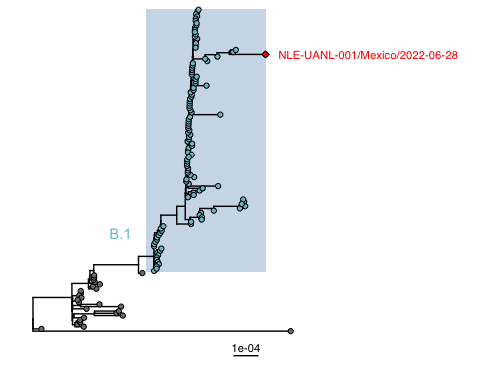July 7 2022
NOTE: author(s) name(s) not visible/available
Monkeypox virus (MPXV) is a zoonotic pathogen that causes a febrile rash disease in humans. It has caused multiple outbreaks in the past (1,2) but recently gained popularity because of a multi-country outbreak where detected cases had no a clear link to Africa (3).
Monkeypox virus is a double-stranded DNA virus which belongs to the genus Orthopoxvirus, within the Poxviridae family (4). Two genetic clades have been characterized: West African and Central African. However, a new classification was proposed: clades 1, 2 and 3 (5). Genomes belonging to the recent outbreaks gather at clade 3 and create the hMPXV1 subclade. The current international 2022 outbreak is named B.1.
As of the 4th of July 2022, Mexico had 27 confirmed monkeypox infections (6). We report a complete genome of the first monkeypox case detected in Nuevo León, Mexico.
A skin swab of the lesions was collected on June 28th, 2022, at Dermatology Service of the University Hospital “Dr. José Eleuterio González”, from a 34 years-old male patient. Viral DNA was extracted from with the High Pure PCR Template Preparation Kit (Roche) in a biological safety cabinet and all the hazardous biological infectious wastes were disposed according to the NOM-087-ECOL-SSA1-2002.
Monkeypox virus was detected by qPCR using the protocol reported by Li (7). DNA was quantified and 700 ng were used to prepare the library with SQK-LSK109, following the manufacturer’s protocol. The library was loaded on a FLO-MIN106 R9.4.1. We used high accuracy basecalling and deplete the human genome by adaptive sampling reference (GRCh38.p14, GCF_000001405.40) in MinKNOW v.22.05.5. The run lasted for 20 h and obtained 84,000 reads. ...
Announcement
Collapse
No announcement yet.
First Monkeypox virus sequence from northern Mexico - Virological
Collapse
X
